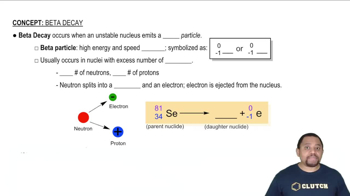Here are the essential concepts you must grasp in order to answer the question correctly.
Half-life
Half-life is the time required for half of the radioactive nuclei in a sample to decay. For Bismuth-210, with a half-life of 5.0 days, this means that after 5 days, half of the original amount will have decayed. Understanding half-life is crucial for calculating the remaining quantity of a radioactive substance over time and predicting the number of decay events that will occur.
Recommended video:
Beta decay
Beta decay is a type of radioactive decay in which a beta particle (an electron or positron) is emitted from an atomic nucleus. In the case of Bismuth-210, it undergoes beta decay, transforming into a different element while releasing energy. This process is essential for determining the number of emissions that occur over a specified time period, as each decay event corresponds to one beta emission.
Recommended video:
Radioactivity and exposure measurement
Radioactivity refers to the process by which unstable atomic nuclei lose energy by emitting radiation. The exposure to radiation can be quantified in curies (Ci), a unit that measures the activity of a radioactive source. To calculate the exposure a person receives from beta emissions, one must consider the total emissions and the percentage intercepted, allowing for an assessment of potential health risks associated with radiation exposure.
Recommended video:
Units of Radiation Measurement
 Verified step by step guidance
Verified step by step guidance

